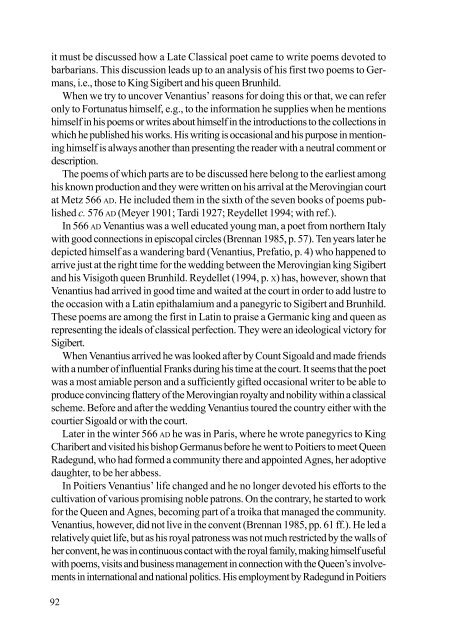Beowulf - Institutionen för arkeologi och antik historia
Beowulf - Institutionen för arkeologi och antik historia
Beowulf - Institutionen för arkeologi och antik historia
Create successful ePaper yourself
Turn your PDF publications into a flip-book with our unique Google optimized e-Paper software.
it must be discussed how a Late Classical poet came to write poems devoted to<br />
barbarians. This discussion leads up to an analysis of his first two poems to Germans,<br />
i.e., those to King Sigibert and his queen Brunhild.<br />
When we try to uncover Venantius’ reasons for doing this or that, we can refer<br />
only to Fortunatus himself, e.g., to the information he supplies when he mentions<br />
himself in his poems or writes about himself in the introductions to the collections in<br />
which he published his works. His writing is occasional and his purpose in mentioning<br />
himself is always another than presenting the reader with a neutral comment or<br />
description.<br />
The poems of which parts are to be discussed here belong to the earliest among<br />
his known production and they were written on his arrival at the Merovingian court<br />
at Metz 566 AD. He included them in the sixth of the seven books of poems published<br />
c. 576 AD (Meyer 1901; Tardi 1927; Reydellet 1994; with ref.).<br />
In 566 AD Venantius was a well educated young man, a poet from northern Italy<br />
with good connections in episcopal circles (Brennan 1985, p. 57). Ten years later he<br />
depicted himself as a wandering bard (Venantius, Prefatio, p. 4) who happened to<br />
arrive just at the right time for the wedding between the Merovingian king Sigibert<br />
and his Visigoth queen Brunhild. Reydellet (1994, p. X) has, however, shown that<br />
Venantius had arrived in good time and waited at the court in order to add lustre to<br />
the occasion with a Latin epithalamium and a panegyric to Sigibert and Brunhild.<br />
These poems are among the first in Latin to praise a Germanic king and queen as<br />
representing the ideals of classical perfection. They were an ideological victory for<br />
Sigibert.<br />
When Venantius arrived he was looked after by Count Sigoald and made friends<br />
with a number of influential Franks during his time at the court. It seems that the poet<br />
was a most amiable person and a sufficiently gifted occasional writer to be able to<br />
produce convincing flattery of the Merovingian royalty and nobility within a classical<br />
scheme. Before and after the wedding Venantius toured the country either with the<br />
courtier Sigoald or with the court.<br />
Later in the winter 566 AD he was in Paris, where he wrote panegyrics to King<br />
Charibert and visited his bishop Germanus before he went to Poitiers to meet Queen<br />
Radegund, who had formed a community there and appointed Agnes, her adoptive<br />
daughter, to be her abbess.<br />
In Poitiers Venantius’ life changed and he no longer devoted his efforts to the<br />
cultivation of various promising noble patrons. On the contrary, he started to work<br />
for the Queen and Agnes, becoming part of a troika that managed the community.<br />
Venantius, however, did not live in the convent (Brennan 1985, pp. 61 ff.). He led a<br />
relatively quiet life, but as his royal patroness was not much restricted by the walls of<br />
her convent, he was in continuous contact with the royal family, making himself useful<br />
with poems, visits and business management in connection with the Queen’s involvements<br />
in international and national politics. His employment by Radegund in Poitiers<br />
92








